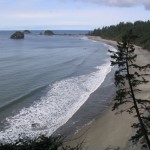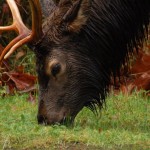The glaciers of the last Ice Age released their grip on Olympic National Park about 10,000 years ago. A warming climate and the slow accumulation of plant and animal waste worked to build the soils in which the forests in their varied forms began to take root. Since the beginning of written history, for thousands of years, the Park’s Old Growth forest has looked much as it does today. Had they seen it, Pharaohs, Prophets, Greeks, Romans, and all of humanity since, would have viewed this ancient forest as it appears today.
Timeless in one sense, the Park’s forest is in a cycle of constant renewal. Changes in climate, and the fortunes of weather and fire can and do alter its growth rate and plant renewal cycle. Regardless of the demands of these change agents, the Park’s forests remain resilient. Resilience and cycles are key to understanding the fundamentals of the forest ecosystem. The forest depends on a huge supply of water, sunlight and nutrients, all of which are present in the Park. Trees and plants, fish and animals die, and their decomposition contributes to the constant and cyclic supply of organic materials. The Park’s notorious rainy weather and daily sunlight (not always sunshine) complete the required list. Variations in the quantity and quality of these ingredients result in the variations that are seen within ONP. Better soils and more rain on the west side results in more robust growth than on the drier east side, where weather and lower water retention result in different species and growth rates. (See Hurricane Ridge.)
While there is a relationship between big and old, it is often deceptive. Trees that are the same age in the Park, while differing by species and location, can vary drastically in size. Take two 50-year old trees, of the same species, one growing in the nutrient-rich and moist soil of the rain forest and the other at elevation on the driest portion of the Park, just south of Sequim (s’kwim) near Obstruction Point. The rain forest tree can easily be the size of a garbage can lid, 2-3 feet in diameter, while the other, growing in the more arid sub-alpine environment is more likely to be as small as a tea saucer, 4-6 inches across.
The oldest trees in the Park are 1,000 years old or more. The most critical phrase in that sentence is, “in the Park.” Outside the Park boundary, the lives of most trees are measured in 20-80 year cycles a result of commercial logging. The vast majority of Old Growth forest exists only because it is protected.. In the case of Olympic National Park, we owe a debt of gratitude to the following, in succeeding order: Presidents Grover Cleveland, Teddy Roosevelt, Franklin Roosevelt; and currently the devoted efforts of the National Park Service, nearby and far away. Virtually every stick of Old Growth timber, on the Olympic Peninsula outside of the Park boundary has been cut. Sadly, some of it for such lowly uses as packing crates. Take the time to view the historic logging photos on the following pages of the University Libraries Digital Collections website. As you do, realize that any one of the logs shown in the pictures was capable of supplying all the lumber needed to frame nine average-sized homes. This was a financially valuable resource, but once cut could not be replaced.
- University Libraries, Digital Collections
- University Libraries, Digital Collections
- University Libraries, Digital Collections
- University Libraries, Digital Collections
- University Libraries, Digital Collections
The Park’s Old Growth forest acts as an air filter, taking in huge quantities of carbon dioxide and exchanging it for oxygen. It manages and regulates the storage and release of water. It’s a laboratory for scientific study and provides benchmark data for entities as diverse as tailed frogs and climate change. Seen by visitors as huge, it exists at the very edge of a sustainable ecosystem by its lack of size. By unlocking its natural recorded history, this land of ancient trees may someday afford us a safer world in which to live out our own cycles of life, but only if we continue protecting this ancient forest.
Here are some related websites:



